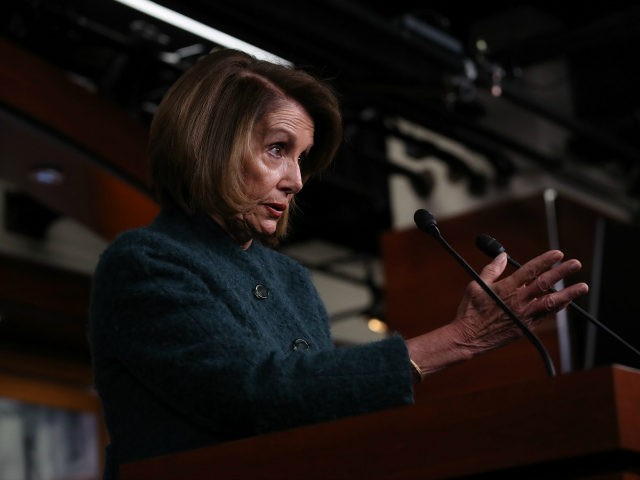Democrats are drafting a plan that would enhance border security with a one-time $5 billion boost in spending — but still not provide a penny for a durable border fence that would curb the smuggling of labor or drugs, states a report in Politico.
The plan is being developed as moderate Democrats break from the party leaders’ policy of opposing a border fence, and it “is expected to include at least $5 billion for border protection efforts like new technology and more law enforcement agents, according to multiple aides,” said Politico.
Trump is stepping up the public pressure on moderate Democrats and is focussing public attention on their leaders’ refusal to build a wall against criminals and drug-smuggling.
The Democrat plan would expand the pending Democratic plan to spend $1 billion extra for one year on improving security at the “Ports of Entry.” Neither plan is expected to include any funding for a border fence that would constrict the smuggling of drugs nor any legal reform that would reduce the smuggling of workers via the various asylum and “catch-and-release” loopholes.
The $5 billion plan is expected to fund “a virtual wall” of sensors.
But prior efforts to build a virtual wall proved to be a practical failure under former Presidents George W. Bush and Barack Obama. In 2011, Obama’s deputies canceled a “virtual wall” program that started under Bush in 2005. The $1 billion SBI-Net technology system proved far less effective than walls, but it provided GOP and Democrat legislators with a media-ready excuse for defunding the 2006 Secure Fence Act, which approved the deployment of 600 miles of double fencing along the border.
In 2016, the public reacted by electing Trump to build a wall.
However, establishment legislators are strenuously opposing Trump’s pro-American mandate. For example, some of Trump’s deputies are now racing to trade Trump’s wage-boosting “Hire American” anti-amnesty policies in exchange for a few billion dollars to build a wall — without fixing the loopholes that allow the trafficking of cheap labor into the U.S. job market.
An increasing number of pro-American groups and activists are worried that business-first Republicans will persuade Trump to abandon his wage-boosting, low-immigration policies to build a few hundred miles of wall:
NYT report said President Donald Trump quietly blocked a stealthy “BRIDGE” amnesty – with advice from Steve Miller. The amnesty would have crippled ICE enforcement & triggered migrant wave during 2020 election. VP Pence shows little aversion to the amnesty https://t.co/i3WyFhijwf
— Neil Munro (@NeilMunroDC) January 22, 2019
Politico reported the Democrats’ planned $5 billion offer:
Speaker Nancy Pelosi plans to formally unveil the proposal Thursday evening, after the Senate takes up its own dueling funding measures to reopen the government. Both are partisan bills that are predicted to fall short of the necessary 60 votes.
…
House Democratic leaders are trying to show movement as some cracks in their caucus begin to show in the unprecedented 33rd day of shuttered government operations.
A handful of moderate Democrats have begun to speak out against Pelosi’s strategy of refusing to negotiate until the government is reopened. A small group, led by freshman Rep. Elaine Luria of Virginia, began circulating a letter this week pressing Pelosi to counter Trump’s proposal with her own potential compromise.
The Democrats’ anti-wall leadership is facing pressure from many Democrats who say they support a fence in high-crime areas along the border:
A poll shows that much of the Democratic partisan opposition to Trump's border wall fades away when voters see it as 'a fence in high-crime areas' — https://t.co/QJrpr3YPes
— Neil Munro (@NeilMunroDC) January 18, 2019
Trump is changing his language and arguments to reach the pro-fence Democrats:
BUILD A WALL & CRIME WILL FALL! This is the new theme, for two years until the Wall is finished (under construction now), of the Republican Party. Use it and pray!
— Donald J. Trump (@realDonaldTrump) January 23, 2019
Even Trump Haters like (MS)NBC acknowledge you “BUILD A WALL & CRIME WILL FALL!” pic.twitter.com/bKIgmHUW5P
— Donald J. Trump (@realDonaldTrump) January 23, 2019
For the last several weeks, Pelosi has been trying to offset Trump’s pressure by promoting the “virtual wall” plan as an alternative to a fence or wall:
Nancy Pelosi is pushing the no-wall 'technology wall' alternative to Trump's actual wall. The PR scam worked for biz under Bush/Obama – until the public picked Trump to build a real wall. But it now might help provide PR cover for Democrats to compromise. https://t.co/HqX024EcTY
— Neil Munro (@NeilMunroDC) January 11, 2019
Nationwide, the bipartisan establishment’s economic policy of using legal migration to boost economic growth shifts wealth from young people towards older people by flooding the market with cheap white-collar and blue-collar foreign labor. That flood of outside labor spikes profits and Wall Street values by cutting salaries for manual and skilled labor of blue-collar and white-collar employees.
The cheap labor policy widens wealth gaps, reduces high tech investment, increases state and local tax burdens, hurts kids’ schools and college education, pushes Americans away from high tech careers, and sidelines at least five million marginalized Americans and their families, including many who are now struggling with fentanyl addictions.
Immigration also steers investment and wealth away from towns in Heartland states because coastal investors can more easily hire and supervise the large immigrant populations who prefer to live in coastal cities. In turn, that investment flow drives up coastal real estate prices, pricing poor U.S. whites, Latinos, and blacks out of prosperous cities, such as Berkeley and Oakland.

COMMENTS
Please let us know if you're having issues with commenting.